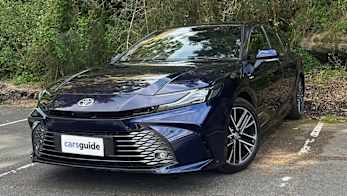When you’ve built your reputation on cheap and cheerful cars, like Hyundai did, it’s always going to be difficult to entice people to pay a premium for your cars on the basis of quality and reliability. Once Hyundai had established itself in the market it was always going to move up the market ladder, away from the cars that gave it its start. For a time dealers bemoaned the company’s shift from its drive-away-no-more-to pay roots.
The move started in the mid-1990s and one of the transition models was the 1995 J2 Lantra.
MODEL WATCH
The Excel was the model Hyundai used to establish its credentials in a doubting world, and the company didn’t do itself any favours by trying to deny there was a problem with the welding of the front end on a number of Excels. The goodwill it was building vanished overnight and the brand took some time to recover.
It was a production glitch that clouded the Excel’s reputation, which was really quite a good little car, and it also affected other models like the Lantra.
The Lantra was a compact model, the next step up the model ladder from the Excel, but it employed the same value-for-money proposition as the Excel.
Its looks were distinctly Asian, a mass of soft curves that appealed to some, appalled others, but at the end of the day it was a matter of individual taste.
Inside there was reasonable room for front seat passengers, but those in the rear were more squeezed, particularly in the sedan. There was more room in the rear of the wagon, which was slightly longer with a longer rear overhang.
The interior fittings were plastic and really looked it, the overriding colour grey. It got the job done, but looked like it was built down to a price.
Lantra power came from a 1.8-litre fuel injected double overhead camshaft four-cylinder engine that was quite responsive when you put your foot down even from low speeds in higher gears. It put out 94 kW at 6100 revs and 165 Nm at 5000 revs and was at its best when spinning briskly.
There was a choice of manual and auto ’boxes, the four-speed auto being the more popular choice. While the auto was smooth, the five-speed manual had a rather clunky shift that felt notchy and there was a tendency to crunch gears unless the clutch was fully depressed.
The Lantra’s chassis was well balanced without having the precision of a sports car and the road holding was reassuring. The rack and pinion power steering was light, the brakes were powerful and the ride comfortable.
Opening the model range was the GL sedan and wagon, which boasted vinyl cloth trim, tilt adjustable steering column, four-speaker radio/cassette sound, split-fold rear seat and anti-skid brakes.
Next up was the GLS, which added central locking, full cloth trim, power windows and mirrors to the package.
There was also the SE, which came in 1996 as a lower priced entry level model.
Air-conditioning was made standard across the range in 1997.
IN THE SHOP
The Lantra’s basic mechanical package is quite sound, it’s the ancillaries that can let you down.
Early Hyundais had problems with their electrical systems, the result of building down to a price. Often it was the connections that caused the problem, the wiring tended to be too tight causing the occasional bad connection.
Paint was a problem with most Korean cars of the time and faded paint is a regular problem.
The engine uses a belt to drive the camshaft and this needs to be changed around the 100,000 km mark, and many Lantras will be approaching the change point for the second time.
Check for a service record to ensure your potential purchase has seen the inside of a service shop. The cheap and cheerful sales pitch meant they often ended up in the hands of owners who didn’t care about servicing or simply couldn’t afford it. A well serviced car will stand the test of time much better than one that hasn’t been serviced.
IN A CRASH
Has ABS anti-skid brakes, which is a plus, but don’t look for airbags.
In recent surveys of real life crashes the Lantra is rated at average so it gets a pass mark.
OWNERS SAY
Marian Emblin has done more than 200,000 km in the Hyundai Lantra SE she bought new in 1997. Its good points, she says, are its spacious interior with plenty of leg/headroom, interior layout, comfortable front seats, attractive design, and its reliability. Not so good is its paint finish, which marks easily, its trim that degraded very quickly, and the boot lip and parcel shelf, which restricts what you can get in the boot. Repairs have been minimal, it's had three batteries, one alternator, one muffler, a throttle switch, and now the auto transmission is showing signs of wear.
LOOK FOR
• Swoopy styling a matter of taste
• Basically sound engineering
• Good ride and handling
• Standard anti-skid brakes
• No airbags
• Faded paint
THE BOTTOM LINE
Nothing flash, but has stood the test of time quite well.
RATING
55/100
Hyundai Lantra 1995: Gl
| Engine Type | Inline 4, 1.8L |
|---|---|
| Fuel Type | Unleaded Petrol |
| Fuel Efficiency | 9.0L/100km (combined) |
| Seating | 5 |
| Price From | $2,090 - $3,300 |












































.jpg)

.jpg)













.png)



.jpg)